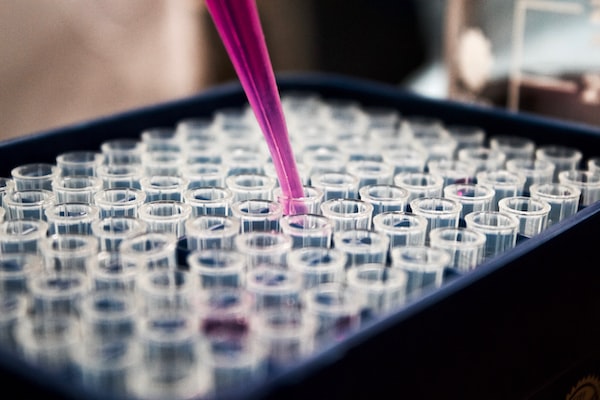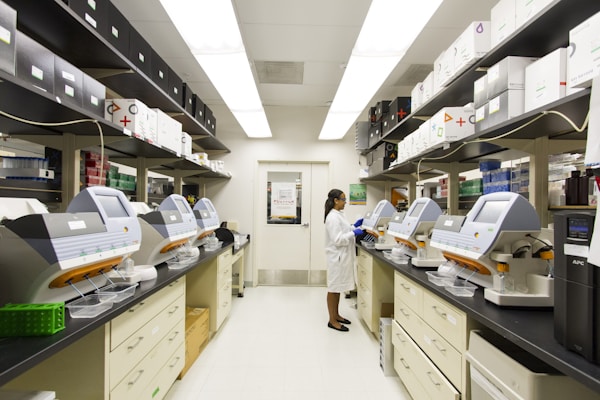Health
New Technologies That Are Changing the Medical Laboratory Profession

Today, medical laboratories are under pressure to do more testing with fewer resources. New technologies are changing the medical laboratory profession and the way laboratories do business. Keep reading to find out how new technologies are changing the medical laboratory profession, and be sure to consider pursing your masters in MLS if this article fascinates you.
Automated Analyzers
Laboratory automation is nothing new—it has been used in various industries for years to speed up processes and improve accuracy. However, automated analyzers are changing the medical laboratory profession in unprecedented ways.
First, automated analyzers are improving the quality of patient care. They are faster and more accurate than manual tests, and they can handle a wider range of tests. This means that patients are getting faster, more accurate results, which leads to better diagnosis and treatment. Second, automated analyzers are reducing the cost of laboratory tests. Automation allows labs to run more tests simultaneously, which reduces the cost of each test. In addition, automated analyzers are more accurate than manual tests, so labs don’t have to spend as much time and money verifying results.
Molecular Diagnostics
Molecular diagnostics are changing the landscape of the medical laboratory profession. With the advent of more sophisticated and sensitive tests, clinicians are able to detect and diagnose diseases at earlier stages, when treatment is more likely to be successful. In addition, molecular diagnostics are being used to monitor the effectiveness of therapies and to detect the presence of drug-resistant mutations.
The use of molecular diagnostics is expanding beyond the traditional areas of oncology and infectious diseases. For example, tests are now available for the diagnosis of rare diseases, such as Pompe disease. Molecular diagnostics are also being used to detect genetic variants that are associated with an increased risk of developing common diseases, such as heart disease and cancer.
Next-Generation Sequencing

Sequencing technology is evolving at a rapid pace, and with it, the medical laboratory profession. In the past, genetic sequencing was a time-consuming and expensive process that could only be performed in a few specialized labs. However, the development of next-generation sequencing (NGS) has made genetic sequencing more affordable and accessible, thus allowing for its use in a wider range of laboratories.
NGS technology is based on the use of microarrays, which allow for the simultaneous sequencing of many DNA fragments. This technology has made it possible to sequence the entire human genome in just a few days. NGS is also being used to sequence the genomes of other organisms, including viruses, bacteria, and parasites. The use of NGS technology is changing the way that medical labs operate. In the past, laboratories were limited to performing a small number of specific tests. However, with the advent of NGS technology, laboratories are now able to sequence any type of DNA fragment. This has led to the development of new and innovative tests that can be used to detect genetic diseases and mutations.
Lab-on-a-Chip
Lab-on-a-Chip technology has the potential to revolutionize the medical lab profession. The miniaturization of laboratory equipment and analysis has allowed for the development of devices that can be used to detect and diagnose diseases in a fast, accurate, and cost-effective manner. The use of Lab-on-a-Chip technology can result in earlier disease detection and treatment, which can lead to improved patient outcomes.
Lab-on-a-Chip technology is also having a significant impact on the way that laboratory tests are performed. The use of microfluidics has allowed for the development of devices that can perform a variety of tests, including blood tests, DNA tests, and drug tests, in a fast and accurate manner. This has led to the development of devices that can be used for point-of-care testing, which allows for the testing of patients in a variety of settings, including hospitals, clinics, and even in their homes.
How new technologies are changing the medical lab profession is overall very important. They are making it easier to diagnose and treat patients, as well as making the process more efficient. This allows for better patient care overall.

Health
Nourish Your Life Today And Expand Your Life Span in 2024

In a world that often demands more than it gives, finding ways to nourish your life can lead to a more fulfilling and balanced existence. Nourishment goes beyond the food we eat; it encompasses our mental, emotional, and physical well-being. To truly nourish your life, it’s essential to cultivate habits and practices that promote overall health and happiness. This comprehensive guide will explore various strategies to help you nourish your life in every aspect.
1. Understanding True Nourishment
What Does It Mean to Nourish Your Life?
Nourishing your life means providing the necessary sustenance for your body, mind, and soul to thrive. It involves adopting a holistic approach that includes healthy eating, mental well-being, emotional balance, and physical fitness.
The Importance of Holistic Well-being
Holistic well-being recognizes the interconnectedness of the different aspects of our lives. By addressing all areas—physical, mental, emotional, and spiritual—we can achieve a state of harmony and balance.
2. Nourishing Your Body
Balanced Nutrition
Eating a balanced diet rich in fruits, vegetables, whole grains, lean proteins, and healthy fats is fundamental to nourishing your body. These foods provide essential nutrients that support overall health and vitality.
Hydration
Staying hydrated is crucial for bodily functions, including digestion, circulation, and temperature regulation. Aim to drink at least 8 glasses of water daily and adjust based on your activity level and environment.
Regular Exercise
Incorporating regular physical activity into your routine helps maintain a healthy weight, boosts energy levels, and improves mood. Choose activities you enjoy, such as walking, cycling, swimming, or yoga.
Adequate Sleep
Quality sleep is essential for physical health and cognitive function. Establish a consistent sleep routine and aim for 7-9 hours of sleep per night to ensure your body can rest and repair.
3. Nourishing Your Mind
Continuous Learning
Keeping your mind active through continuous learning helps maintain cognitive function and mental agility. Engage in activities like reading, puzzles, learning a new skill, or taking up a hobby.
Mindfulness and Meditation
Practicing mindfulness and meditation can reduce stress, enhance focus, and promote emotional stability. Start with a few minutes each day and gradually increase the duration as you become more comfortable.
Mental Health Support
Seeking support for mental health issues is crucial. Therapy, counseling, and support groups can provide valuable resources for managing stress, anxiety, depression, and other mental health conditions.
4. Nourishing Your Emotional Health
Building Resilience
Resilience is the ability to bounce back from adversity. Cultivate resilience by developing a positive outlook, practicing self-compassion, and maintaining a strong support network.
Emotional Expression
Expressing emotions in a healthy way is vital for emotional health. Journaling, talking to a friend, or engaging in creative activities like art or music can help process and express feelings.
Healthy Relationships
Building and maintaining healthy relationships contribute significantly to emotional well-being. Invest time in nurturing connections with family, friends, and loved ones.
5. Nourishing Your Spirit
Finding Purpose and Meaning
Having a sense of purpose and meaning in life is essential for spiritual nourishment. This can come from work, hobbies, volunteering, or other activities that provide a sense of fulfillment.
Spiritual Practices
Engaging in spiritual practices, whether through religion, meditation, or personal reflection, can enhance your sense of connection and inner peace.
Nature Connection
Spending time in nature can be incredibly grounding and rejuvenating. Activities like hiking, gardening, or simply sitting in a park can foster a deeper connection with the natural world.
6. Practical Steps to Nourish Your Life
Setting Goals
Set realistic and achievable goals that align with your values and passions. Having clear goals gives direction and purpose, motivating you to make positive changes.
Creating a Routine
Establishing a daily routine that includes time for self-care, work, and leisure helps create balance. Consistency in your routine can lead to better habits and improved well-being.
Self-Care Practices
Self-care involves taking deliberate actions to care for your physical, mental, and emotional health. This could include activities like taking a relaxing bath, reading a book, or practicing yoga.
7. Overcoming Barriers to Nourishment
Time Management
One of the biggest challenges to nourishing your life is finding the time. Prioritize your well-being by scheduling time for activities that nourish you, and learn to say no to commitments that drain your energy.
Staying Motivated
Maintaining motivation can be difficult. Surround yourself with supportive people, track your progress, and celebrate small victories to stay motivated on your journey.
Access to Resources
Access to resources like healthy food, fitness facilities, and mental health support can be a barrier. Explore community resources, online programs, and affordable options to overcome these challenges.
8. The Benefits of a Nourished Life
Improved Physical Health
Adopting nourishing habits can lead to better physical health, including increased energy levels, improved immune function, and reduced risk of chronic diseases.
Enhanced Mental Clarity
Nourishing your mind through continuous learning and mental health support can enhance cognitive function, memory, and mental clarity.
Greater Emotional Stability
Practicing emotional expression and building resilience can lead to greater emotional stability, reducing stress and improving overall mood.
Deeper Spiritual Connection
Engaging in spiritual practices and finding purpose can lead to a deeper sense of connection and inner peace, enriching your life experience.
Conclusion
Nourishing your life is an ongoing journey that requires intentional effort and commitment. By addressing all aspects of well-being—physical, mental, emotional, and spiritual—you can achieve a balanced and fulfilling life. Remember, small, consistent changes can lead to significant improvements in your overall well-being.
FAQs
1. How can I start incorporating mindfulness into my daily routine?
Begin with short sessions of mindfulness meditation, focusing on your breath and being present in the moment. Gradually increase the duration and try to incorporate mindfulness into everyday activities like eating and walking.
2. What are some affordable ways to improve personal well-being?
Affordable ways to improve well-being include practicing yoga at home, using free health apps, engaging in outdoor activities, and connecting with supportive communities online or locally.
3. How does wearable technology benefit personal well-being?
Wearable technology helps track physical activity, monitor sleep patterns, and provide health insights, enabling individuals to make informed decisions about their well-being and maintain healthy habits.
4. What are some effective stress management techniques?
Effective stress management techniques include mindfulness meditation, deep breathing exercises, physical activity, journaling, and spending time in nature.
5. How can I maintain a work-life balance?
Maintain a work-life balance by setting boundaries, prioritizing tasks, taking regular breaks, and ensuring time for personal activities and relaxation. Flexible working conditions and ergonomic workspaces also help in achieving this balance.
Health
How Europeans can use surrogacy in Ukraine to find their happiness

Surrogacy has emerged as a viable option for individuals and couples across the globe facing challenges with conception or pregnancy. Among the countries offering surrogacy services, Ukraine has gained prominence as a popular destination, attracting prospective parents from Europe and beyond. In this comprehensive guide, we delve into the landscape of surrogacy in Ukraine, providing insights, considerations, and essential information for European individuals and couples exploring this pathway to parenthood.
The Legal Landscape of Surrogacy
One of the primary draws of surrogacy in Ukraine for European intended parents is its favorable legal framework. Ukrainian legislation permits surrogacy arrangements, providing a clear legal pathway for establishing parental rights. The country’s laws prioritize the rights of intended parents, ensuring that they are recognized as the legal parents of the child born through surrogacy, with the surrogate and her husband (if applicable) relinquishing all parental rights.

Medical Expertise and Infrastructure
Ukraine boasts a robust medical infrastructure and a wealth of fertility clinics with advanced technologies and experienced professionals specializing in assisted reproductive techniques. Prospective parents can access comprehensive medical evaluations, fertility treatments, and surrogacy services tailored to their specific needs.
Surrogacy in Ukraine: Affordability and Accessibility
Compared to surrogacy options in other European countries or the United States, surrogacy in Ukraine is often more affordable, making it an attractive option for European individuals and couples seeking cost-effective alternatives. The relatively lower cost does not compromise the quality of medical care or legal protections, offering a compelling value proposition for prospective parents.
Ethical Considerations
While Ukraine provides a conducive legal and medical environment for surrogacy, prospective parents should approach the process with ethical considerations in mind. It is essential to prioritize the well-being and rights of all parties involved, including the surrogate, egg donor (if applicable), and the child. Open communication, transparency, and respect for the autonomy and dignity of the surrogate are paramount throughout the surrogacy journey.
Cultural and Logistical Factors of Surrogacy
European intended parents embarking on the surrogacy journey in Ukraine may encounter cultural and logistical differences. Understanding and navigating these nuances, including language barriers, cultural norms, and logistical arrangements, are integral to ensuring a smooth and successful surrogacy experience.
Surrogacy in Ukraine offers European individuals and couples a promising pathway to parenthood, combining legal clarity, medical expertise, affordability, and accessibility. By familiarizing themselves with the legal framework, medical infrastructure, ethical considerations, and cultural aspects of surrogacy in Ukraine, prospective parents can make informed decisions and embark on their journey to building a family with confidence and peace of mind.
Health
Best DNA Testing Kits: Discover The Secrets Stored In Your Genes

We all want to learn more about our identities. Who lived in the past before us? From whence did they originate? Do we have relatives that we are unaware of? DNA testing businesses will reportedly address these questions. Many at-home genealogy DNA tests available today may help you determine your ethnic background, locate long-lost relatives, or reveal the origins of your ancestor tens of thousands of years ago.
Cheats For The DNA Test Kit
It’s understandable why these tests are well-liked; the International Society of Genetic Genealogy (ISOGG) estimates that more than 18 million individuals have purchased at-home DNA test kits. You’ll get a percentage breakdown of the places your genes originate from in a couple of weeks.
| Best Building & Villa Maintenance services |
| villa renovation |
| gulf interior wood |
| building renovation services |
| villa renovation in Dubai |
Some tests go even further, and look at your father line and mother line to figure out your family’s old travel patterns on both sides. Numerous tests compare you to others in their databases who share your DNA
Ancestry Service Provided By 23andme
In many respects, 23andMe fulfills the promises made by companies that provide Facial recognition app at home. You may anticipate receiving a sizable quantity of data about your Ancestry, genetic characteristics, and relatives in its system.
23andMe is the best option for detail and diversity. The two available variations are the $99 Ancestry Service and the $199 Health + Ancestry Service. An interactive, visually rich report on your ethnic Ancestry, information on your mother’s and father’s ancient ancestors, a database of people you share DNA with, and even a report on traits inherited from Neanderthals are all features of the less expensive Ancestry Service, which still outperforms most other tests.
AncestryDNA
AncestryDNA delivers straightforward instructions and interactive results online along with a growing database of ancestors and ethnic identities, living up to what you’d expect from a DNA kit. For a few reasons, AncestryDNA is a great DNA test. Because it has tested the DNA of more than 10 million individuals, it possesses the world’s biggest DNA database. This increases the chance of discovering relatives while also increasing the estimations’ accuracy. Second, to improve the precision of its findings, AncestryDNA routinely updates its ethnicity estimations using fresh DNA samples. As a consequence, for the one-time payment of $99, you may anticipate seeing your results improve over time.
MyHeritage D.N.A
MyHeritage, which offers the same service as AncestryDNA with a few extra bonuses, including DNA comparison with family members and the capacity to upload DNA from other suppliers, is the global equivalent of AncestryDNA.
MyHeritage DNA provides a comprehensive service for just $79 dollars at the lowest cost. (Keep an eye out for frequent sales that lower the price to $59) Since it calculates your ethnic background using your autosomes and connects you with relatives who share DNA with you, MyHeritage DNA is similar to Ancestry DNA in many respects.
Ancestry DNA Is The Best DNA Kit For Genealogy.
AncestryDNA delivers straightforward instructions and interactive results online along with a growing database of ancestors and ethnic identities, living up to what you’d expect from a DNA kit. Due to the longevity of its service and the bigger database from which to pull family history, AncestryDNA earns the second top rank on our list.
The sole rival is MyHeritage, which also provides a genealogy service with access to public data and other resources. There is a monthly service charge for Ancestry.com’s genealogy service, which begins at $20.
DNA Family Tree
Because it is the oldest DNA testing business, Family Tree DNA’s findings and website seem antiquated compared to newer, more modern services like 23andMe and AncestryDNA. However, it does take privacy seriously while providing intriguing findings, team initiatives, and matching paternal and maternal families.
Even though permission forms are optional, 23andMe has teamed up with pharmaceutical industry leaders like GlaxoSmithKline to “exchange” genetic information. While AncestryDNA has “shared” DNA data with Alphabet’s Calico laboratories, the parent company of Google. (We include the word “share” in quotation marks since some businesses get an unspecified advantage in exchange for their data.) Family Tree DNA is the test for you if you want to take a DNA test but are worried about privacy.
How To Interpret A DNA Test
It might not be easy to know precisely what to look for given the abundance of DNA testing now available and the addition of new ones every year. But before you order a test, a few crucial factors tell you how accurate it will be.
An autosomal test, which may provide information about your ancestors and which ethnicities can be detected in your DNA, is the most common sort of DNA test. In addition, some dna paternity test Dallas TX also examine your mother’s mtDNA and, if you’re a man, your DNA in addition to your autosomes. You generally receive your money’s value if a test examines more than your autosomes.
Lastly, find out how big the test database is. As was previously indicated, the test service gets access to additional data as the DNA database grows, which helps to improve its algorithms and science.

 Others1 year ago
Others1 year agoDavid T Bolno: Why Giving Back To The Community Is So Crucial

 Travel1 year ago
Travel1 year agoPractical And Essential Car Interior Accessories To Add Comfort And Convenience To Your Drive

 Travel1 year ago
Travel1 year agoBusiness Visa for CANADA

 Fashion1 year ago
Fashion1 year agoTips For Choosing The Right For Engagement Diamond Rings

 Tech1 year ago
Tech1 year agoThe Best Way to Never Get Lost: Buy Wayfinding Signs!

 Business1 year ago
Business1 year agoTop Reasons Why you Need to Consider Outsourcing Real Estate Photo Editing

 Health1 year ago
Health1 year agoGarlic Is The Best Vegetable To Treat Heart Problems

 Business1 year ago
Business1 year agoDead And Co Setlist What They Played At The Gorge Amphitheatre